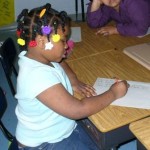“You write in order to change the world, knowing perfectly well that you probably can’t, but also knowing that literature is indispensable to the world… The world changes according to the way people see it, and if you alter, even by a millimeter, the way … people look at reality, then you can change it.” -James Arthur Baldwin

Most teachers make a mental connection to Tabor Rotation when I ask them to think about how schools instruct in a balanced literacy program. Students’ brains have to make a connection to what they are learning in any subject. This is a well-known and well-emphasized fact in literacy instruction, but it is not always of primary importance in mathematics- it should be!
In the book Educating Everybody’s Children (Robert Cole, Editor), they say that all learners, especially the diverse learner, needs the following in math:
- Relate math to real-world experiences of their own.
- Work cooperatively to solve problems.
- Explore concepts with hands-on materials.
- Use calculators and computers.
- Construct one’s own mathematical knowledge.
- Write and talk about math.
All teachers have to do is use the same comprehension strategies they are teaching in literacy when teaching math. Students need to be encouraged and given plenty of opportunities to write and talk about math, connect it to their own world, work cooperatively, and explore concepts in a hands-on way. Tabor Rotation assists the teacher in facilitating that.
Going right along with using the comprehension strategies that all good readers use, in every subject and every occasion, is writing in order to better understand what you have just experienced. Writing in math should be a daily activity. In Tabor Rotation, students should carry their Math Journals with them to each group or activity and take notes on the left side of the book. On the next page, the right side, they turn their notes into explanations, illustrations, and descriptions. Every person in the room is writing during this time…including all the adults who were assisting. The most important model in the room and the person with the most influence is the teacher. If he writes, then the students will realize the importance of it. If a student is an emerging writer, then he can record what he has learned by drawing.
Some people get caught up in the fact that they can’t afford composition books or math journals. If you have any kind of paper that can be fastened together, your students have a math journal! Begin by modeling, scaffold support as they write, and share what is written from the Mathematician’s Circle on Friday.
Every state math test is also a reading and writing test, too. So, read and write in math on a daily basis and you won”t have to sweat when test time comes!!!
“The discipline of the writer is to learn to be still and listen to what his subject has to tell him.” -Rachel Louise Carson

